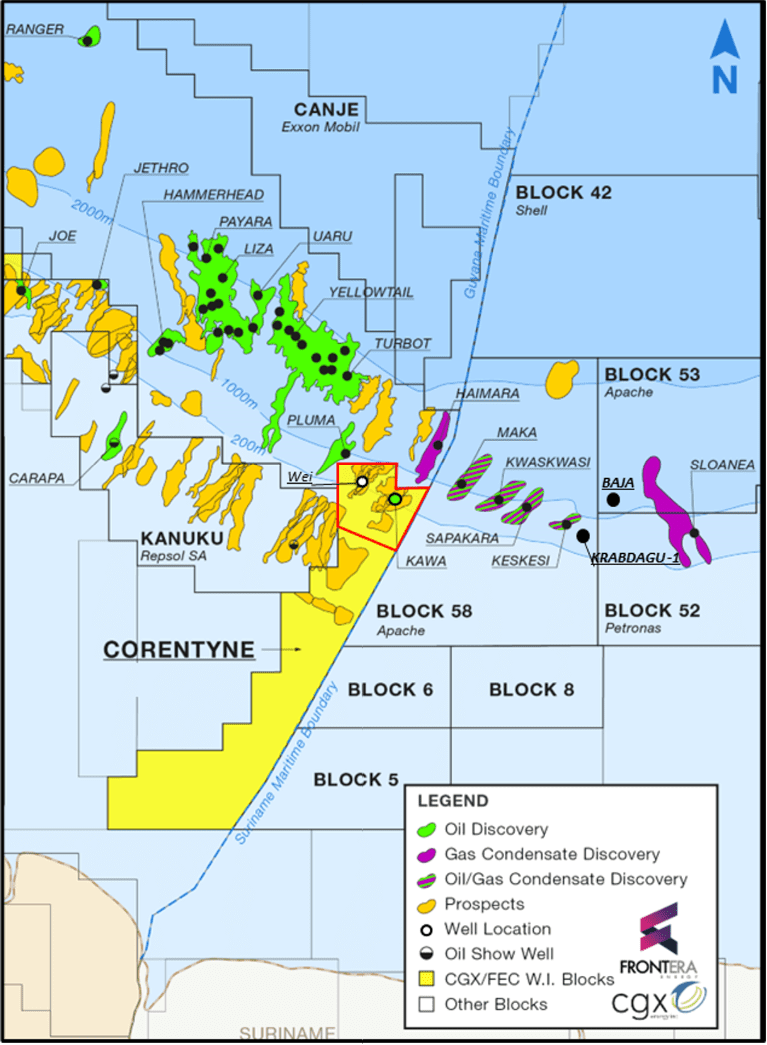When CGX Energy Inc. announced a discovery at the Kawa-1 well in February 2022, expectations soared. For the first time in 20 years, CGX had finally delivered a historic find, potentially placing Guyana on track for a second major offshore oil project outside of ExxonMobil’s Stabroek Block. But CGX soon moved on to another prospect.
The focus shifted to Wei-1, a new prospect targeting stacked Campanian and Santonian channels in the Corentyne Block. CGX staked everything on it. A US$35 million loan deal with Frontera Energy Corporation helped fund operations, backed by all of CGX’s assets. That loan allowed Frontera to expand its influence.
CGX said the Kawa-1 data raised Wei-1’s chance of success from 29% to 56%. But money troubles escalated. CGX surrendered majority ownership in the Corentyne Block. Frontera took a 68% participating interest. CGX retained just 32%.
The Wei-1 well gained attention. In 2022 and 2023, Westwood and Rystad Energy each flagged it as a high-impact well. But drilling faced months of delays. In response, Guyana tightened its contract rules to prevent similar setbacks.
By March 2023, CGX sold over 76% of its common shares to Frontera. Frontera gained complete voting control.
In July 2023, CGX and Frontera announced that Wei-1 had struck oil. The well encountered 210 feet of hydrocarbon-bearing sands in the Santonian. Wireline logs and core samples were taken, but oil samples could not be retrieved due to tool failure. A third-party lab analyzed the data. The final November 2023 result: just 13 feet of net pay in the Maastrichtian, 61 feet in the Campanian, and 40 feet in the Santonian. Investors were underwhelmed. Stocks fell.
Still, CGX highlighted the Maastrichtian interval, which held medium sweet crude at 24.9 API, similar to Exxon’s Liza find. Combined Kawa-1 and Wei-1 drilling showed 81 feet of net pay in the Maastrichtian. Estimates for that layer suggested 514 to 628 million barrels of oil equivalent, enough to support a standalone project; however, further drilling was needed to prove it. This was a tough call for an operator that was almost out of time and had little to no remaining opportunities to raise money.
CGX made a final attempt to hold onto the Corentyne Block. It failed. The Guyanese government was not confident that CGX had the funding to keep working. The block was returned to the State. CGX and Frontera maintain they still hold a valid license. Arbitration is a possibility, but that path seems unlikely as Guyana remains resolute that the license is cancelled.
In the end, what started as CGX’s long-awaited breakthrough ended with the loss of its prized asset and the rise of Frontera as the new major player.
But while CGX’s long bet on Corentyne didn’t pay off, the story may not end there. The Block still holds promise. With the right investor and commitment, Corentyne could still deliver the breakthrough CGX hoped for, only under a different name.



